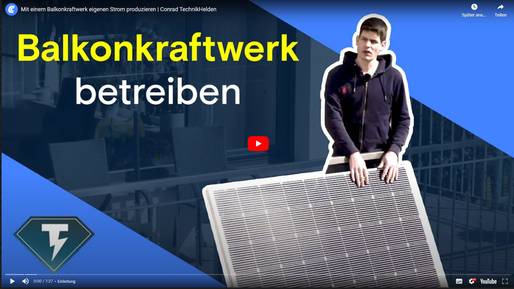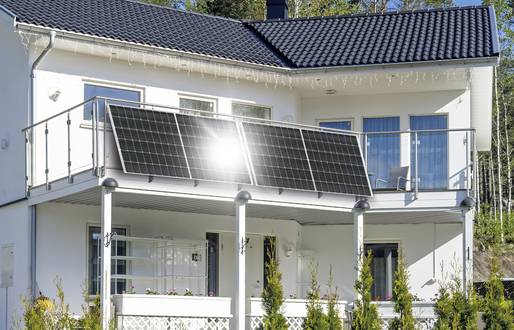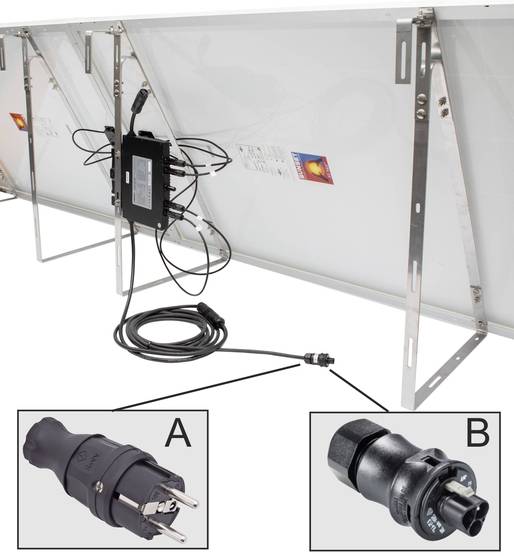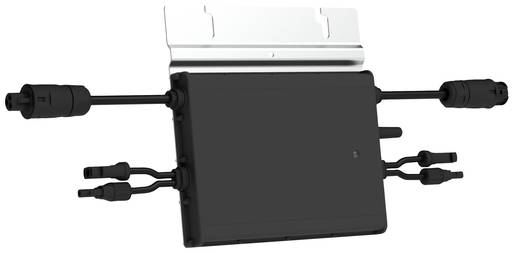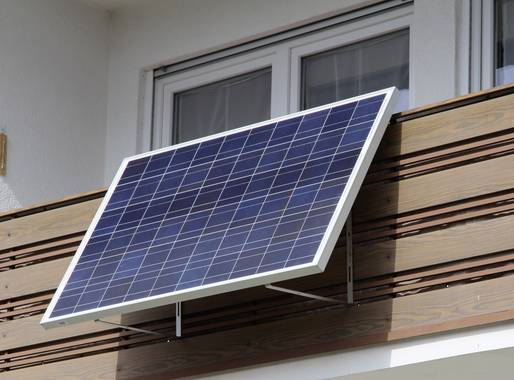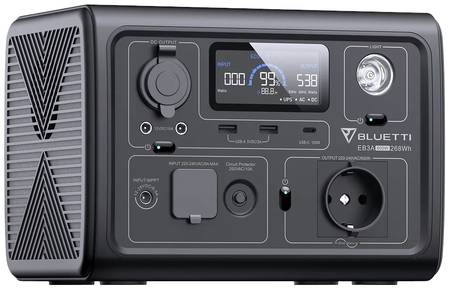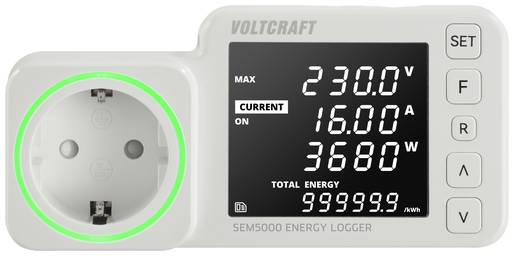Build balcony power plants yourself or as a set » Balcony solar systems help save electricity
Updated: 27.05.2024 | Reading time: 7 minutes
This text is machine translated.
Why buy expensive electricity when the sun shines for free and can easily be converted into electrical energy with the help of a solar system? In the wake of rising energy prices, more and more people are asking themselves this question and thinking about how they can save on costs. It is ideal if you have your own house or a company building where the roof surface can be used to install a solar system. It is less good if you live in a rented property and therefore do not have sufficient installation space for an extensive solar system with grid feed-in.
Smaller solar power systems, known as balcony power plants, have been developed so that these people, as well as anyone who is reluctant to invest in a large solar power system, can also benefit from the advantages of a photovoltaic system.
These are usually offered as complete sets. However, these systems are not always fully suitable for every application. Alternatively, it is possible to put together the perfect photovoltaic balcony system individually. We will be happy to show you the possibilities and provide you with further information on the subject of balcony power plants.
But the most important thing first: Balcony power plants and the necessary components are also eligible for solar subsidies in Germany and are therefore offered in our online store with 0% VAT.
A balcony power plant is a small solar system in which up to four solar modules can be mounted on a balcony railing without major installation effort and in a space-saving manner. Hence the name. The electricity generated by the modules is fed into the household power grid with the help of a micro inverter. To do this, the inverter is simply connected to the solar modules and plugged into a safety socket.
These performance features and the ingeniously simple plug'n'play property are particularly practical for tenants, as no work needs to be done on the building fabric or the building electrics.
A little manual skill is all that is needed for installation and commissioning.
The electricity generated by a balcony power station is primarily used to support the power supply to the apartment or house when the sun is shining.
A maximum electrical output of 800 W (0.8 kW) is then available when the sun is shining.
Incidentally, many homeowners who do not want to install a large system also like to use a complete balcony system to save energy costs. In this case, the solar modules can be mounted on garages, carports or green areas, optimally aligned with the sun. It is even possible to mount the photovoltaic system on the wall of the house.
Solar balcony power plants are an absolute hot topic at the moment. And anyone who takes a closer look will recognize more and more solar modules on balcony railings or garage roofs. This is not surprising, as balcony solar systems are offered in many places as complete sets that only need to be installed or set up.
You definitely don't need a specialist to do this work. Any experienced DIY enthusiast with a little manual skill can easily do it themselves.
Even the electrical connection is very easy with the plug-in kit offers. All you need to do is connect the solar modules to the micro inverter and the inverter to a nearby mains socket. So far, so simple.
But there is one point that needs to be considered when selecting the set: the socket connection. This is because the mains connection cables of the micro inverters are equipped with either an earthing contact plug (A) or a triangular Wieland plug (B).
If a safety plug is fitted, the plug will fit into any conventional mains socket. If the connecting cable is fitted with a Wieland plug, a Wieland supply socket must be installed on site by a qualified electrician.
Alternatively, it is also possible to use a Wieland adapter cable with a safety plug.
Our product recommendations for balcony power station sets
The solar modules in a balcony power plant set have a size defined by the manufacturer. Unfortunately, however, the dimensions of the photovoltaic modules do not always perfectly match the planned installation location. They are either too wide and too short or too narrow and too long. This can visibly disrupt the appearance of the building. However, it is not only the appearance that can be optimized with an individually assembled balcony power plant. The technology can also be optimized.
Solar panels
Since the German government's Solar Package I came into force, the maximum permissible feed-in power into the electricity grid has been 800 watts. However, to ensure that the maximum possible feed-in power can be achieved even when solar radiation is not optimal, the installation of several modules (at least three) is recommended in order to generate significantly more power.
A standard module has a nominal output of around 400 to 440 watts peak (Wp). If you are planning a balcony system with a feed-in potential of 800 watts, you therefore need at least two modules.
In contrast to solar panels in set offers, when putting together an individual balcony system, you can select exactly the modules that are perfectly suited both mechanically and electrically.
Even expanding the system is quite simple with individual additional modules. In view of the changes brought about by Solar Package I, operators of a system with a 600 watt inverter, for example, should consider an upgrade. Either by connecting an additional inverter with an output of 200 watts or by replacing the old one with a new 800 watt inverter. The latter is particularly useful if the old inverter is at least 5 years old.
Popular solar panels for building balcony power plants
Micro inverter
Just like the modules, the inverter is also an integral part of a set. However, there are quite big differences in the inverters, which are only noticeable on closer inspection.
In addition to the various connection options, ease of use and data readout, efficiency is probably the most important point that should be taken into account.
A high-quality inverter can often deliver a significantly better yield under the same conditions than the inexpensive inverter from the set.
Upgradeable inverters that can be converted from 600 watts to 800 watts via software are ideal. In this case, the hardware does not need to be changed when converting.
Technical tip in passing
Many micro inverters have two AC voltage outputs. One output is required for connection to the power grid and further micro inverters of the same type can be connected in series to the second output if required. This is of interest if the balcony power plant is to be extended. In this case, the existing inverter can continue to be used. Also very practical: if the inverter allows wireless communication. Then the performance data can be conveniently read out using a smartphone or tablet.
Popular micro inverters for building balcony power plants
A general tip in advance: Before purchasing a system, people who live in rented accommodation should always ask the landlord in person whether an installation is generally permitted or possibly tolerated.
Just as important! Not everything that fits together perfectly mechanically also fits together perfectly electrically. This is why people who want to put together a photovoltaic balcony power plant must have sound specialist knowledge in this area. If this is lacking, we strongly recommend contacting suitable specialists who can help with planning, installation and commissioning.
Compared to inexpensive balcony power station sets, putting together an individual balcony system is significantly more expensive or involves higher costs. Especially if high-quality products with a good level of efficiency are selected. However, the increased product quality will have a positive effect later on in the form of a significantly higher yield and an expected longer service life.
Observe the maximum rated output!
As part of Solar Package I, the German government has stipulated that a balcony power plant may no longer exceed a total installed nominal output of 2,000 Wp (watt peak).
Practical mounting accessories
The basic idea of a balcony solar system is to cover energy requirements during the day. In times of working from home, this is perfect if the electricity for the computer, monitor(s), router etc. is generated from renewable sources. But what happens if the power requirement drops to a minimum during the day because nobody is at home? Or what happens if more electricity is produced than consumed on a sunny day?
In these cases, the electricity from the balcony system is fed into the public grid free of charge.
It would be much cleverer to store the electricity not required during the day in a power station so that the self-generated electricity is available in the evening, thus reducing electricity costs.
In the simplest case, the power station is connected to the 230 V mains either directly or via a power supply unit. With the help of a smart plug adapter or a timer, the power supply to the power station and thus the charging process is only activated at certain times.
Popular power stations
When purchasing a balcony solar system, many people ask themselves whether it is ultimately worth it financially. This question can definitely be answered with a “yes”. However, it is not possible to determine exactly how long it will take for the investment to pay for itself. To do this, the actual yield of the balcony solar system would first have to be determined on site.
Energy cost meters that can also be operated in the “reverse direction” are ideally suited to this task.
This is because these measuring devices can not only record the consumption of a connected electrical appliance. They are also able to record the energy fed into the power grid and display it according to their design.
The results can then be used to calculate the payback period and monitor the system performance in the long term.
Energy cost meters with “reverse function”
Important:
Most feed-in sockets are located near the solar modules and therefore on the balcony or in other outdoor areas. The protection class of the energy cost meter must be designed accordingly or suitable weather protection must be provided.
Can a solar balcony system also be installed on a roof or flat roof?
Yes, this is possible. However, additional components such as brackets or module stands are required for mounting or installation on a roof or flat roof.
Do the individual solar modules have to be aligned in the same way?
With most Duo Micro inverters, the module inputs are not directly connected to each other electrically. It is therefore possible to align one solar module to the south and one solar module to the west, for example.
However, this means that the combined maximum output of both modules is no longer fully achieved. However, this is not necessarily tragic if the modules are generously dimensioned. However, the generation profile, i.e. the period for efficient energy generation, is significantly extended.
Can I operate two balcony power stations at the same time?
In principle, one balcony power station is permitted per electricity meter. This means that only one balcony power station is permitted per detached house or apartment with one electricity meter.
In an apartment building with several parties, which also have separate electricity meters, several systems or balcony power plants are therefore also permitted.
Are balcony power plants with more than 2000 Wp module output still permitted?
New balcony power plants with a total module output of more than 2000 Wp have no longer been permitted since the beginning of 2024. However, existing XL balcony power plants with a module output of 2200 Wp, for example, do not have to be dismantled.
Does a solar balcony power plant have to be registered?
For a long time, small power generators under 800 W were classified as “not significant” by the European Union, but German grid operators still insisted on registration.
This changed with the introduction of “Solar Package I” (May 16, 2024): since then, balcony power plants can be commissioned without registering with the local grid operator. However, registration in the Federal Network Agency's market master data register is still mandatory. The latter can be done relatively easily online and even up to 1 month after the system has been connected.
Does a balcony power plant also supply electricity when the sky is cloudy?
Yes, but compared to a cloudless sky, the output of the modules is significantly lower. For this reason, the modules of the system should be larger so that sufficient grid feed-in power is still achieved.
Can a balcony power station bridge a power failure?
Unfortunately not, because the micro inverter always needs the mains voltage for synchronization. Otherwise it would not be possible to feed power into the grid. So if there is no mains voltage, the photovoltaic balcony power station will not supply any electricity. Even when the sun is shining fully on the solar panels.
What happens if more electricity is generated than is consumed?
The surplus electricity generated is then fed into the power grid. The feed-in limit is 800 watts.
However, attention should be paid to the electricity meter. With older meters that are still equipped with the classic “turntable”, the meter would run backwards, which is not permitted. In this case, a new meter must be installed by the grid operator. In addition, a balcony power plant with 600-800 watts is a rather small system that is not expected to generate a significant surplus of electricity in the long term.
Is the electricity fed into the grid remunerated?
As there is no contract with the energy supplier, the electricity fed into the grid is not remunerated. In addition, the output of a balcony solar system is limited. For this reason, electricity is only fed into the public grid in rare cases - and then only to a limited extent.
Is any earthed socket suitable for the power supply?
Yes, this works without any problems. As the electricity meter is balancing, it offsets the energy flows within the three phases of the house connection against each other. As a result, it does not matter which of the three phases the system feeds into.
Can a storage tank be connected to a balcony power plant?
A large high-capacity electricity storage system (BESS) only really makes sense if the solar modules deliver a high yield and therefore also a considerable surplus. The electricity that is not needed at the moment can then be stored for the evening or night hours.
With most photovoltaic balcony power plants, however, the electricity yield is far too low to be able to fill a storage unit with electricity in addition to the daily requirement. However, if electricity consumption during the day is minimal, the energy generated by the balcony system can be used to recharge a power station.
We strongly advise against unprofessional solutions with old truck batteries and inadequate charge controllers. This has already caused serious damage on several occasions.
